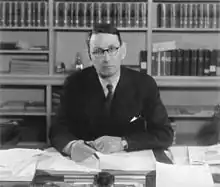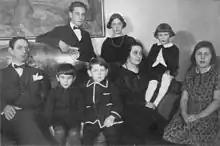Yngve Larsson | |
|---|---|
 Yngve Larsson in his office at Stockholm City Hall, around 1930s | |
| Born | December 13, 1881 Sundsvall, Sweden |
| Died | December 16, 1977 (aged 96) Stockholm, Sweden |
| Nationality | Swedish |
| Education | Ph.D., political science |
| Occupation | politician |
| Children | Yngve A. A. Larsson |
Gustaf Richard Yngve Larsson (Swedish: [ˈʏ̌ŋːvɛ ˈlɑ̌ːʂɔn]; December 13, 1881 – December 16, 1977) was a Swedish political scientist, Municipal commissioner (Borgarråd), and Member of Parliament. He was an important force in the urban development of Stockholm during the post-war years, and came to be called his century's foremost Swedish city builder and Stockholm politician.
Life
Yngve Larsson was born in Sundsvall but moved to Stockholm in the early 1890s with his family. He studied in Uppsala and was for a time active in radical politics. His graduate studies took place partly in Heidelberg and Berlin, and his doctoral thesis of 1913 focused on issues of urban planning and city administration, which would be the focus of his later career.[1]
Originally a Social Democrat, Larsson was expelled from the party in 1915 for proposing Swedish collaboration with Germany in order to guarantee Finland's independence from Russia. After a few years outside party politics, he joined the Liberal Party in the late 1920s and, after a merger, was a successful candidate for the People's Party (currently The Liberals).[1][2]
During the Second World War Larsson was a leading advocate for pro-Nordic anti-Nazi politics, and a board member of Samfundet Nordens Frihet[1] and chairman of Svensk-Norska föreningen.
He was a marked modernist and was for 22 years a leading vice Mayor of Stockholm, in charge of urban development, and politically leading behind several of the city's largest urban development projects of the 20th century, including Slussen, Stockholm Metro and the major redevelopment of Norrmalm borough in central Stockholm. Larsson's role in the post-war planning of Stockholm and its new suburbs was internationally recognized. The American city planner Clarence Stein wrote that:
They have developed an organization for city building that is second only to that of the London County Council. But it differs from that in having a broader, more complete goal and ideal. This has been due I think largely to Yngve Larsson's statesmanship; also to his sympathetic understanding with Markelius and Sidenbladh as architect-planners, and with Holger Blom (an architect, too), who makes the parks throughout Stockholm rich with blooming color.
Later judgments, however, have pointed at the sleazy preparatory work; it was for example assumed that the big corporations needed central offices in central Stockholm but when they were offered building lots after the clearances they declined. Stockholm Municipality was almost bankrupt in 1970 from having to fill the cleared lots at its own expense. Larsson came later to regret his own work and tried, in vain, to stop the clearances.[4]
He was awarded several Swedish and foreign state orders. In 1946, King Haakon VII appointed Larsson as a Commander with Star of the Norwegian Order of St. Olav "for particularly outstanding merits of the Norwegian Resistance during the war." He also received the French Legion of Honour, Swedish Order of the Polar Star and Order of Vasa and the Order of the White Rose of Finland.[5]

Yngve Larsson was married to Elin (1884-1980), née Bonnier, and they had six children, including later professor Yngve A. A. Larsson.
References
- 1 2 3 Sidenbladh, Göran (1978). "G R Yngve Larsson". Svenskt Biografiskt Lexikon. National Archives of Sweden. Retrieved 2022-12-16.
- ↑ "Volume 13. Kufstein - Longör". Runeberg.org. Nordisk familjebok (in Swedish) (4th ed.). 1951. Retrieved 2022-12-16.
- ↑ Stein 1998, p. 600
- ↑ Jan Jörnmark: Norrmalmsregleringen, ISBN 9789197984287 [Göteborg], Tangent förlag, [2018]
- ↑ Harnesk, Paul; Davidsson, Åke (eds.). "Vem är Vem? / Stor-Stockholm 1962". runeberg.org (in Swedish). p. 757. Retrieved 2022-12-16.
- Yngve Larsson at Swedish Wikipedia
Literature in English
- Thomas Julius Anton (1975). Governing Greater Stockholm: A Study of Policy Development and System Change. Berkeley: University of California Press. ISBN 978-0-520-02718-3.
- Deland, Mats [in Swedish] (2001). The Social City : Middle-way approaches to housing and sub-urban governmentality in southern Stockholm, 1900-1945 (PDF). Stockholm: Stockholms universitet. ISBN 978-91-88882-17-2.
- Larsson, Yngve (1962). "Building a city and a metropolis : the planned development of Stockholm". Journal of the American Institute of Planners. USA. 28 (4): 220–228. doi:10.1080/01944366208979448.
- Larsson, Yngve; Pieter de Wolff [in Dutch]; Lauchlin Currie (1967). Governmental planning and political economy. Royer Lectures. Berkeley, California: Institute of Business and Economic Research, Institute of Governmental Studies, University of California.
- Oser, Jacob (1967). "Reviewed work(s): Governmental Planning and Political Economy by Yngve Larsson; Pieter deWolff; Lauchlin Currie". Journal of Economic Issues. 1 (3): 244–246. doi:10.1080/00213624.1967.11502777. JSTOR 4223854.
- Pass, David (1973). Vällingby and Farsta - from idea to reality: the new community development process in Stockholm. Cambridge, Massachusetts: The MIT Press. ISBN 978-0-262-16034-6.
- Skårfors, Rikard (1999). Beslutsfattandets dilemma: planarbete och opinionsyttringar rörande trafikleder i Stockholm 1945-1975. Working papers in transport and communication history, 1104-6988 ; 1999:2. Uppsala: Uppsala University.
- Stein, Clarence (1998). Kermit C. Parsons (ed.). The Writings of Clarence S. Stein: Architect of the Planned Community. Baltimore, Maryland: Johns Hopkins University Press. ISBN 978-0-8018-5756-0.
External links
![]() Media related to Yngve Larsson at Wikimedia Commons
Media related to Yngve Larsson at Wikimedia Commons